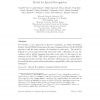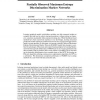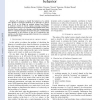98 search results - page 7 / 20 » Competing Hidden Markov Models on the Self-Organizing Map |
CSL
2011
Springer
13 years 2 months ago
2011
Springer
We describe a new approach to speech recognition, in which all Hidden Markov Model (HMM) states share the same Gaussian Mixture Model (GMM) structure with the same number of Gauss...
NIPS
2008
13 years 9 months ago
2008
Learning graphical models with hidden variables can offer semantic insights to complex data and lead to salient structured predictors without relying on expensive, sometime unatta...
IROS
2006
IEEE
14 years 1 months ago
2006
IEEE
— We propose to classify the behaviors of a mobile robot thanks to topological methods as an alternative to metric ones. To do so, we adapt an analysis scheme from Physics of non...
ECCV
2002
Springer
14 years 9 months ago
2002
Springer
Abstract. Natural scenes consist of a wide variety of stochastic patterns. While many patterns are represented well by statistical models in two dimensional regions as most image s...
TASLP
2002
13 years 7 months ago
2002
This paper presents a framework for maximum a posteriori (MAP) speaker adaptation of state duration distributions in hidden Markov models (HMM). Four key issues of MAP estimation, ...



